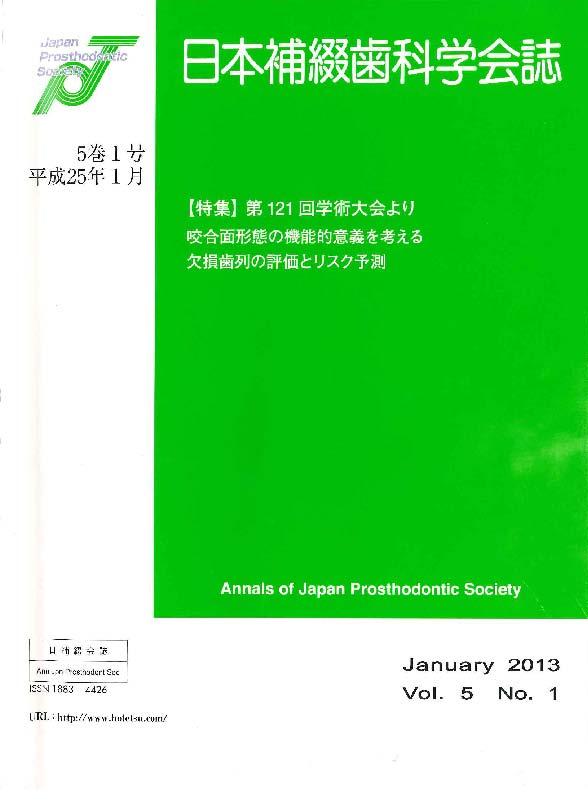Volume 5, Issue 1
The 121st Scientific Meeting of Japan Prosthodontic Society
Displaying 1-20 of 20 articles from this issue
- |<
- <
- 1
- >
- >|
Invited Articles
The 121st Meeting of Japan Prosthodontic Society - Symposium 3 -
-
2013Volume 5Issue 1 Pages 1-2
Published: January 10, 2013
Released on J-STAGE: February 22, 2013
Download PDF (1380K) -
2013Volume 5Issue 1 Pages 3-7
Published: January 10, 2013
Released on J-STAGE: February 22, 2013
Download PDF (1646K) -
2013Volume 5Issue 1 Pages 8-13
Published: January 10, 2013
Released on J-STAGE: February 22, 2013
Download PDF (1884K) -
2013Volume 5Issue 1 Pages 14-18
Published: January 10, 2013
Released on J-STAGE: February 22, 2013
Download PDF (1505K)
The 121st Meeting of Japan Prosthodontic Society - Clinical Relay Session 2 -
-
2013Volume 5Issue 1 Pages 19-20
Published: January 10, 2013
Released on J-STAGE: February 22, 2013
Download PDF (1480K) -
2013Volume 5Issue 1 Pages 21-27
Published: January 10, 2013
Released on J-STAGE: February 22, 2013
Download PDF (2851K) -
2013Volume 5Issue 1 Pages 28-33
Published: January 10, 2013
Released on J-STAGE: February 22, 2013
Download PDF (2600K) -
2013Volume 5Issue 1 Pages 34-36
Published: January 10, 2013
Released on J-STAGE: February 22, 2013
Download PDF (1963K)
Original Articles
-
2013Volume 5Issue 1 Pages 37-46
Published: January 10, 2013
Released on J-STAGE: February 22, 2013
Download PDF (1837K) -
2013Volume 5Issue 1 Pages 47-55
Published: January 10, 2013
Released on J-STAGE: February 22, 2013
Download PDF (1784K) -
2013Volume 5Issue 1 Pages 56-64
Published: January 10, 2013
Released on J-STAGE: February 22, 2013
Download PDF (1678K)
Technical Procedure
-
2013Volume 5Issue 1 Pages 65-71
Published: January 10, 2013
Released on J-STAGE: February 22, 2013
Download PDF (1903K)
Case Report (Specialist)
-
2013Volume 5Issue 1 Pages 72-75
Published: January 10, 2013
Released on J-STAGE: February 22, 2013
Download PDF (1491K)
Case Reports (Specialist)
-
2013Volume 5Issue 1 Pages 76-79
Published: January 10, 2013
Released on J-STAGE: February 22, 2013
Download PDF (1612K) -
2013Volume 5Issue 1 Pages 80-83
Published: January 10, 2013
Released on J-STAGE: February 22, 2013
Download PDF (1662K) -
2013Volume 5Issue 1 Pages 84-87
Published: January 10, 2013
Released on J-STAGE: February 22, 2013
Download PDF (1702K) -
2013Volume 5Issue 1 Pages 88-91
Published: January 10, 2013
Released on J-STAGE: February 22, 2013
Download PDF (1645K) -
2013Volume 5Issue 1 Pages 92-95
Published: January 10, 2013
Released on J-STAGE: February 22, 2013
Download PDF (1549K) -
2013Volume 5Issue 1 Pages 96-99
Published: January 10, 2013
Released on J-STAGE: February 22, 2013
Download PDF (1737K) -
2013Volume 5Issue 1 Pages 100-103
Published: January 10, 2013
Released on J-STAGE: February 22, 2013
Download PDF (1784K)
- |<
- <
- 1
- >
- >|
